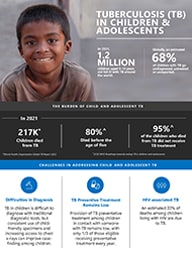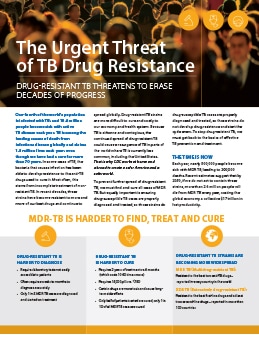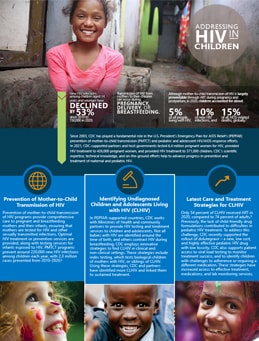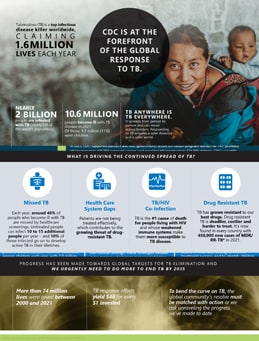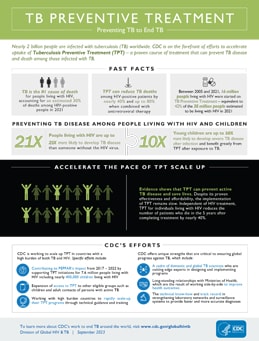Global TB Overview
Overview
Two billion people – one fourth of the world’s population – may be infected with tuberculosis (TB), with 10.6 million becoming ill each year. Despite being preventable and treatable, TB remains a deadly disease. Globally, over 3,500 people lose their lives to TB each day – totaling 1.3 million deaths each year. Additionally, around 30 percent of people who become ill with TB are missed by healthcare screenings and diagnostics and do not get the care they need, leading to poor health outcomes and an increased spread of TB in communities. Each of these untreated people can infect 10 to 15 additional people per year – and 10% of those infected go on to develop active TB in their lifetimes.
CDC and partners are working on the frontlines in the world’s highest TB and TB/HIV burden countries to understand what’s driving the spread of TB and how to stop it. To make progress – and find the missing millions who do not receive the healthcare needed – we must address the drivers of this epidemic in the most at-risk populations and increase access to TB preventive measures. By taking immediate and effective action, we can change the course of the epidemic and finally make TB history.
CDC’s Contributions
With unmatched scientific and technical knowledge and long-standing relationships with ministries of health, CDC is on the frontlines in 42 high TB or TB/HIV burden countries to prevent, find, and cure TB.
Prevent
CDC and partners identify TB hotspots for targeted screening, strengthen infection control practices in health facilities and communities, and scale treatment to prevent TB among vulnerable populations. With the strategic use of data, CDC is able to help partners increase impact and cost-effectiveness – all while saving lives.
Diagnose
CDC provides a proven track record in strengthening laboratories and surveillance systems. Through robust partnerships, CDC is expanding access to better screening, improving case-finding approaches to identify new patients, enhancing testing strategies to optimize diagnostics, and providing training and technical support to scale faster diagnostic tools.
Treat
CDC’s cadre of global and domestic experts inform U.S. and global efforts in the TB response. By working closely with ministries of health, CDC is able to help implement high-quality treatment programs, broaden access and improve linkage to care, assess costs to patients, optimize and evaluate TB and drug-resistant TB treatment regimens, and improve treatment adherence.

Sustain
CDC’s experience building large and sustainable TB and public health programs is unparalleled. Through strategic and on-going partnerships, CDC works to develop and strengthen surveillance and laboratory systems; expands workforce and research capacity through guidelines mentorship, and training programs; strengthen programs through operational research, implementation, and evaluation.
CDC’s Contributions to Ending HIV-Associated TB
What’s New
Learn how CDC and partners are advancing efforts to end TB through research and innovation.
- Machine Learning to Predict Bacteriologic Confirmation of Mycobacterium Tuberculosis in Infants and Very Young Children PLOS Digit Health This paper used and evaluated machine learning to predict microbial TB in young infants in Kenya.
- Quantifying Mycobacterium tuberculosis Transmission Dynamics Across Global Settings: A Systematic Analysis | AM J Epidemiol This report reviews patient-focused interventions that facilitated successful treatment retention and improved programmatic outcomes in persons with DRTB in Dharavi.
- Retaining Patients with Drug-Resistant Tuberculosis on Treatment During the COVID-19 Pandemic — Dharavi, Mumbai, India, 2020–2022 | MMWR This report reviews patient-focused interventions that facilitated successful treatment retention and improved programmatic outcomes in persons with DRTB in Dharavi.
- The Economic Burden of Households Affected by Tuberculosis in Brazil: First National Survey Results, 2019-2021 PLOS ONE This study established a baseline for monitoring catastrophic costs associated with TB and determined the magnitude and main drivers in Brazil.
- Use of High-Resolution Geospatial and Genomic Data to Characterize Recent Tuberculosis Transmission, Botswana Emerging Infectious Diseases In this article, whole-genome sequencing on M. tuberculosis DNA was performed on sputum cultures from a population-based TB study in Botswana to better understand TB transmission.
Resources
CDC’s Division of Global HIV & TB offers the following resources, which can be shared across various networks.
- Factsheets
- Treating TB in the United States Learn how CDC is engaging with communities across the United States to sustain impact in areas disproportionately affected by TB.
- National TB Cost Surveys Learn about the CDC-supported WHO report of national surveys in 20 countries estimating the costs faced by TB patients and their households.
- Roadmap Towards Ending TB in Children Learn about the CDC and partners are contributing to the WHO report, which builds upon a decade of progress to provide high-quality TB care to the most vulnerable.
- TB Operational Handbook: Infection Prevention and Control Learn about the CDC-supported WHO handbook on infection prevention and control to curb the TB burden worldwide.


